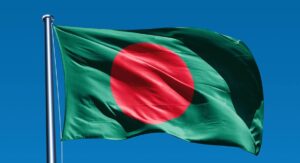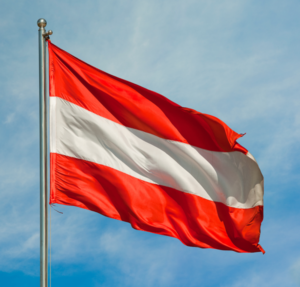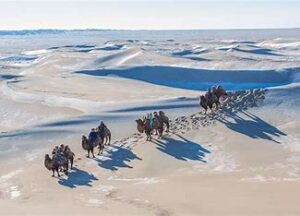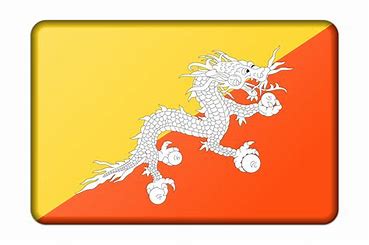
Here are the top 10 historical sites for tourists in Bhutan, each with a brief introduction:
1. Tiger’s Nest Monastery (Paro Taktsang)
2. Punakha Dzong
3. Tashichho Dzong
4. Trongsa Dzong
5. Rinpung Dzong
6. Kyichu Lhakhang
7. Jambay Lhakhang
8. Simtokha Dzong
9. Chimi Lhakhang
10. National Museum of Bhutan
1. Tiger’s Nest Monastery (Paro Taktsang) Bhutan.
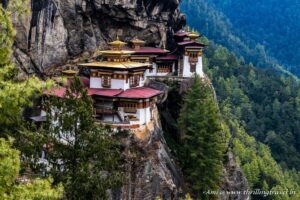
Perched dramatically on a cliffside in the Paro Valley of Bhutan, Tiger’s Nest Monastery, or Paro Taktsang, is a sacred and iconic site that epitomizes Bhutan’s spiritual and cultural heritage.
This Himalayan Buddhist monastery is not only a place of pilgrimage but also a breathtaking marvel of architecture and natural beauty.
Approaching Tiger’s Nest Monastery, tourists journeyed through pine forests and steep trails, offering glimpses of cascading waterfalls and panoramic vistas of the valley below.
The trail itself is part of the experience; moreover, with prayer flags fluttering in the breeze and occasional encounters with monks or locals on their way to worship, it offers a truly immersive journey.
Several temples and buildings interconnected by stairways and pathways cling to the cliffside at an altitude of 3,120 meters (10,240 feet) in the monastery complex.
Legend has it that Guru Padmasambhava, known as the Second Buddha, meditated in a cave here in the 8th century; consequently, this gave rise to the monastery’s sacred significance.
Visitors can explore the intricate murals, statues, and prayer halls within Tiger’s Nest, each adorned with vibrant paintings depicting Buddhist deities and teachings.
Moreover, the main temple, adorned with gold and precious gems, houses the sacred meditation cave where Guru Padmasambhava is believed to have meditated.
A visit to Tiger’s Nest Monastery offers a spiritual journey and a chance to witness Bhutan’s unique cultural heritage amidst stunning natural surroundings.
Whether hiking the trails, marveling at the architecture, or absorbing the tranquil atmosphere, tourists will enjoy the mysticism and beauty of this revered Bhutanese landmark.
2. Punakha Dzong Bhutan.
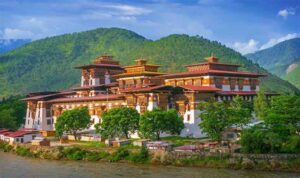
Punakha Dzong is one of the historical sites in Bhutan and attracts tourists to this place.
Punakha Dzong, or Pungtang Dechen Phodrang Dzong, is a majestic fortress monastery at the confluence of Pho Chhu and Mo Chhu rivers in Bhutan.
Built in 1637, this impressive architectural masterpiece serves as both a religious center and administrative hub, embodying Bhutanese traditions and cultural heritage.
Approaching Punakha Dzong, tourists are greeted by its whitewashed walls, golden roofs, and towering wooden entryways adorned with intricate carvings of Buddhist motifs and symbols.
The dzong’s strategic location on a riverbank, surrounded by lush greenery, furthermore, adds to its picturesque setting, making it one of the most photogenic landmarks in Bhutan.
Visitors cross the Mo Chhu River’s cantilever bridge to Punakha Dzong’s courtyard, encountering a serene, spiritual, and historical atmosphere.
The dzong’s expansive complex houses numerous temples, halls, administrative offices, and monk quarters; additionally, all these are connected by narrow corridors and stone-paved paths.
Additionally, one of the main attractions within Punakha Dzong is the Maitreya Temple, dedicated to the future Buddha and featuring a towering statue adorned with colorful silk scarves and offerings from devotees.
The dzong also houses the sacred relics of Zhabdrung Ngawang Namgyal, the founder of Bhutan.
Furthermore, Punakha Dzong is renowned for hosting significant ceremonies and events, including the coronations of Bhutanese kings and the annual Punakha Tshechu festival, where masked dances and religious rituals celebrate Bhutanese culture and spirituality.
A visit to Punakha Dzong offers tourists a glimpse into Bhutan’s rich history, architectural splendor, and religious traditions. Moreover, it provides a memorable experience amidst the tranquil beauty of the Punakha Valley.
Guided tours and cultural performances further enrich the visitor’s understanding of this cultural gem in the heart of Bhutan.
3. Tashichho Dzong Bhutan.
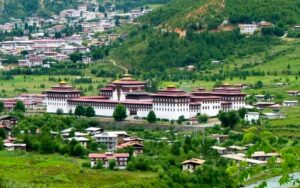
Tashichho Dzong is one of 6he historical sites for tourists, located in the capital city of Thimphu, Bhutan, and is a prominent fortress-monastery and administrative center that exemplifies Bhutanese architecture, culture, and governance.
Built in the 17th century and extensively renovated over the years, Tashichho Dzong serves as the seat of the Bhutanese government, housing the throne room and offices of the King of Bhutan, ministries, and various government agencies.
Approaching Tashichho Dzong, tourists are greeted by its impressive whitewashed walls, towering golden roofs, and traditional Bhutanese architectural elements such as intricate woodwork, large courtyards, and fortified walls.
Moreover, the dzong’s strategic location on the banks of the Wang Chhu River offers stunning views of the surrounding mountains and forests, adding to its serene and picturesque setting.
Visitors enter Tashichho Dzong through a grand entrance adorned with colorful paintings depicting Buddhist teachings and mythological figures.
Additionally, vibrant murals, statues of Buddhist deities, and ceremonial objects that reflect Bhutan’s deep-rooted spiritual traditions adorn the dzong’s inner courtyard and temples inside.
Furthermore, the temple dedicated to the protective deity Palden Lhamo, featuring a massive statue and intricate frescoes depicting her exploits, is one of the main attractions within Tashichho Dzong.
The dzong also houses the main administrative offices, where tourists can observe the daily operations of Bhutan’s government and learn about the country’s unique system of governance.
Tashichho Dzong plays a central role in Bhutanese culture and heritage, hosting important religious ceremonies, cultural festivals such as the Thimphu Tshechu, and official state events.
A visit to Tashichho Dzong offers tourists a profound insight into Bhutan’s governance, spirituality, and cultural traditions, providing a memorable experience amidst the tranquility and grandeur of this iconic landmark in Thimphu.
4. Trongsa Dzong Bhutan.
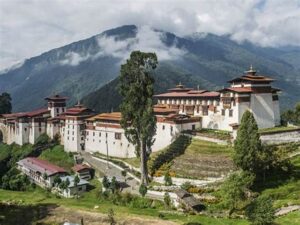
A historic fortress monastery sits on a ridge overlooking a river valley in central Bhutan.
This imposing structure, dating back to the 17th century, holds great significance as both a religious center and a strategic stronghold in Bhutanese history.
It is one of the historical sites and its solid white walls, traditional architecture of Bhutan, and intricately carved wooden balconies and windows welcome tourists.
Moreover, the dzong’s strategic location offers panoramic views of the surrounding mountains and valleys, making it a picturesque and commanding presence in the landscape.
Inside Trongsa Dzong, visitors enter through a massive gateway adorned with colorful paintings depicting Buddhist teachings and mythological figures.
Furthermore, the inner courtyard of the dzong is a labyrinth of temples, administrative offices, monk quarters, and assembly halls, all connected by narrow corridors and stone-paved paths.
Additionally, the inner courtyard of the dzong is a labyrinth of temples, administrative offices, monk quarters, and assembly halls, all connected by narrow corridors and stone-paved paths.
One of the main attractions within Trongsa Dzong is the Tower of Trongsa. This six-story watchtower offers insights into Bhutan’s military history and strategic importance during the era of warring factions.
The dzong also houses the sacred relics of Zhabdrung Ngawang Namgyal, the unifier of Bhutan, making it a revered pilgrimage site for Bhutanese Buddhists.
Trongsa Dzong serves as a cultural and administrative hub for the region, hosting important religious festivals such as the Trongsa Tshechu and ceremonies that celebrate Bhutanese culture and spirituality.
Guided tours of the dzong provide tourists with a deeper understanding of Bhutan’s history, architecture, and traditional way of life, offering a memorable experience amidst the tranquil beauty of central Bhutan.
5. Rinpung Dzong Bhutan.
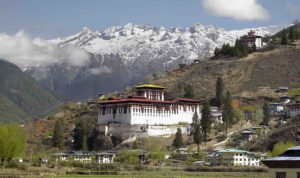
Rinpung Dzong attracts tourists as it is one of the historical sites, located in Paro Valley, Bhutan, a magnificent fortress-monastery that exemplifies traditional Bhutanese architecture and is an important religious and administrative center.
Built in the 17th century by Zhabdrung Ngawang Namgyal, the unifier of Bhutan, Rinpung Dzong stands proudly on a hillside overlooking the Paro Chhu river, offering visitors a captivating glimpse into Bhutan’s cultural heritage.
Moreover, approaching Rinpung Dzong, its majestic whitewashed walls strike tourists, towering golden roofs adorned with intricate wood carvings, and a series of fortified towers and entrance gates.
The dzong’s strategic location provides panoramic views of the lush valley below and the surrounding mountains, creating a serene and picturesque atmosphere.
Additionally, a complex of temples, administrative offices, monk quarters, and assembly halls greet visitors upon entering Rinpung Dzong’s inner courtyard through the Main Gate.
Vibrant murals depicting Buddhist teachings, mythical creatures, and historical events adorn the courtyard, reflecting Bhutan’s rich cultural and spiritual traditions.
Furthermore, one of the main attractions within Rinpung Dzong is the temple of the Protector deity, where resident monks conduct elaborate ceremonies and rituals.
Within Rinpung Dzong, resident monks conduct elaborate ceremonies and rituals in the temple of the Protector deity, which is one of the main attractions.
Moreover, locals and pilgrims alike revere a collection of ancient thangka paintings, statues of Buddhist deities, and sacred relics housed in the dzong.
Rinpung Dzong plays a central role in Paro’s cultural life, hosting the annual Paro Tshechu festival, a vibrant celebration of dance, music, and religious rituals.
Guided tours of the dzong offer tourists insights into Bhutanese history, architecture, and spirituality, providing a memorable experience amidst its tranquil grandeur.
6. Kyichu Lhakhang Bhutan.
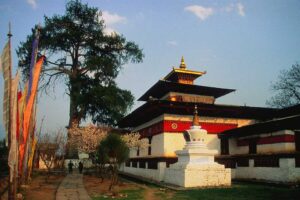
Kyichu Lhakhang, located in the Valley of Paro Bhutan attracts tourists as it is one of the country’s oldest historical sites and one of the most revered Buddhist temples, celebrated for its historical significance, spiritual atmosphere, and architectural charm.
Believed to have been built in the 7th century by the Tibetan Buddhist king Songtsen Gampo, Kyichu Lhakhang is renowned as one of the 108 temples he constructed to subdue a giant ogress that was obstructing the spread of Buddhism.
Visitors enter the main gateway into a sacred atmosphere within Kyichu Lhakhang’s inner courtyard.
The temple complex consists of two main shrines, each housing ancient statues and relics of Buddhist deities, including a revered statue of the Future Buddha, Maitreya.
Inside the temple, tourists can admire the exquisite murals and frescoes that depict scenes from Buddhist mythology and teachings, as well as intricate woodwork and carvings that showcase Bhutanese craftsmanship.
Kyichu Lhakhang holds a special place in Bhutanese religious and cultural life, attracting pilgrims and visitors seeking blessings, spiritual solace, and a deeper connection to Buddhism.
The temple’s peaceful ambiance and historical significance make it a must-visit destination for tourists exploring the rich cultural heritage and spiritual traditions of Bhutan.
7. Jambay Lhakhang Bhutan.
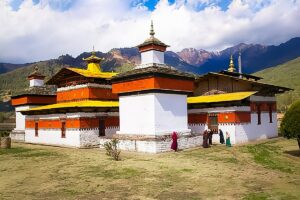
Located in the Bumthang Valley of Bhutan, Jambay Lhakhang attracts tourists as it is one of the historical sites, a venerable and ancient Buddhist temple of great religious and cultural importance.
Believed to have been built in the 7th century by the Tibetan king Songtsen Gampo, the temple is part of a group of 108 temples constructed to subdue a demoness obstructing the spread of Buddhism in the Himalayan region.
As tourists approach Jambay Lhakhang, a serene and picturesque setting amidst verdant fields and rolling hills greets them.
The temple’s exterior features whitewashed walls adorned with colorful murals depicting Buddhist teachings and mythological figures.
Traditional Bhutanese architectural elements such as intricately carved wooden windows, door frames, and roofs add to the temple’s charm and cultural significance.
One of the main attractions within Jambay Lhakhang is the Maitreya Temple, which houses a statue of Maitreya, the Future Buddha, believed to bring blessings and good fortune to devotees.
The temple also hosts the annual Jambay Lhakhang Drup festival, a vibrant celebration featuring masked dances (Cham) and religious rituals aimed at warding off evil spirits and bringing prosperity to the community.
A visit to Jambay Lhakhang offers tourists a profound glimpse into Bhutan’s rich religious traditions, architectural beauty, and cultural heritage.
Whether exploring the temple’s sacred halls or participating in local festivities, visitors are sure to be captivated by the spiritual ambiance and historical significance of this ancient Bhutanese landmark.
8. Simtokha Dzong Bhutan.
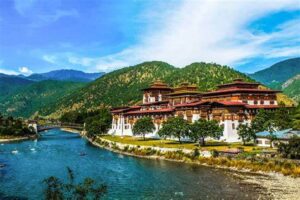
Simtokha Dzong, located just outside the capital city of Thimphu in Bhutan, is an ancient fortress monastery known for its historical significance, religious teachings, and stunning architecture.
Built in 1629 by Zhabdrung Ngawang Namgyal, the dzong is renowned as the first fortress of its kind in Bhutan, serving both as a strategic military outpost and a center for Buddhist education.
Approaching Simtokha Dzong, tourists are greeted by its imposing whitewashed walls adorned with traditional Bhutanese architectural features such as intricately carved wooden windows, doors, and decorative motifs.
The dzong’s strategic location on a ridge overlooking the Thimphu Valley offers panoramic views of the surrounding mountains and countryside, creating a picturesque and serene atmosphere.
Entering through the main gateway, visitors enter Simtokha Dzong’s inner courtyard, which houses a complex of temples, administrative offices, monk quarters, and assembly halls.
Moreover, vibrant murals depicting Buddhist teachings, mythical creatures, and historical events adorn the courtyard, reflecting Bhutan’s rich cultural heritage and spiritual traditions.
Additionally, within Rinpung Dzong, resident monks conduct elaborate ceremonies and rituals in the temple of the Protector deity, which is one of the main attractions.
Furthermore, Simtokha Dzong continues to play a significant role in Bhutanese society, hosting religious ceremonies, cultural events, and educational programs aimed at preserving and promoting the country’s unique heritage.
A visit to Simtokha Dzong offers tourists a deeper understanding of Bhutan’s history, architecture, and spiritual traditions, providing a memorable experience amidst the tranquility and grandeur of this historic landmark.
9. Chimi Lhakhang Bhutan.
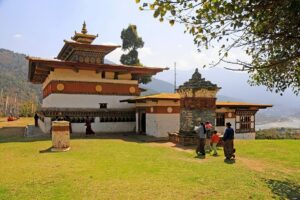
Chimi Lhakhang attracts tourists as it is one of the historical sites, nestled in the lush countryside of Punakha Valley in Bhutan, a unique and revered Buddhist temple known for its fertility blessings and colorful history.
Built in 1499 by the renowned Tibetan saint Drukpa Kunley, also known as the “Divine Madman,” Chimi Lhakhang attracts both pilgrims seeking blessings for fertility and curious tourists drawn to its cultural significance and picturesque surroundings.
Approaching Chimi Lhakhang, tourists are greeted by a scenic trail winding through rice fields and traditional Bhutanese villages, offering glimpses of rural life and the stunning landscape of the Punakha Valley.
Moreover, colorful prayer flags fluttering in the breeze adorn the temple’s exterior, adding to its spiritual ambiance and charm.
Entering through the main entrance, visitors are welcome into Chimi Lhakhang’s inner courtyard, which features a small temple dedicated to Drukpa Kunley.
Phallus paintings and symbols, which are believed to ward off evil spirits and bless visitors with fertility, adorn the temple walls.
Consequently, this makes it a unique cultural experience in Bhutan.
Additionally, one of the main attractions within Chimi Lhakhang is the revered statue of Drukpa Kunley, adorned with silk scarves and offerings from devotees seeking blessings.
The temple also hosts the annual Chimi Lhakhang Drup festival, where masked dances (Cham) and religious rituals celebrate the legacy of Drukpa Kunley and promote prosperity and well-being.
A visit to Chimi Lhakhang not only offers tourists a glimpse into Bhutan’s colorful folklore, religious traditions, and rural life but also provides a memorable and culturally enriching experience amidst the tranquil beauty of the Punakha Valley.
10. National Museum of Bhutan Bhutan.
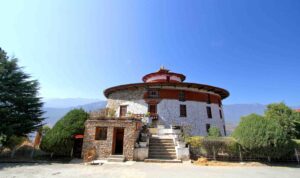
The National Museum of Bhutan, located in the hilltop town of Paro, is a captivating repository of Bhutanese cultural heritage, history, and art.
Housed in the Ta Dzong, an ancient watchtower overlooking the Paro Valley, the museum offers tourists a comprehensive journey through Bhutan’s rich past and traditions.
Approaching the National Museum, tourists are struck by the Ta Dzong’s imposing circular structure, which dates back to the 17th century and was originally built as a defensive fortress.
Following its renovation and conversion into a museum in 1968, it showcases a remarkable collection of artifacts, artworks, religious relics, and ethnographic displays that illustrate Bhutan’s unique cultural identity.
Inside the museum, visitors can explore a series of galleries arranged thematically to highlight different aspects of Bhutanese history and culture.
Exhibits range from ancient weaponry and armor to religious statues and thangka paintings depicting Buddhist iconography.
The museum’s collection also includes traditional costumes, musical instruments, household items, and archaeological finds that provide insights into daily life in Bhutan throughout the centuries.
One of the highlights of the National Museum is the impressive collection of Bhutanese stamps, showcasing the country’s vibrant philatelic history and unique designs.
Informative displays, audiovisual presentations, and guided tours complement the museum’s exhibits, enhancing visitors’ understanding of Bhutanese traditions, beliefs, and societal norms.
A visit to the National Museum of Bhutan offers tourists a deeper appreciation for the kingdom’s cultural richness and historical evolution, set against the backdrop of Paro’s scenic beauty and the majestic Himalayan landscape.
It’s a must-visit destination for anyone seeking to unravel the layers of Bhutanese identity and heritage.


